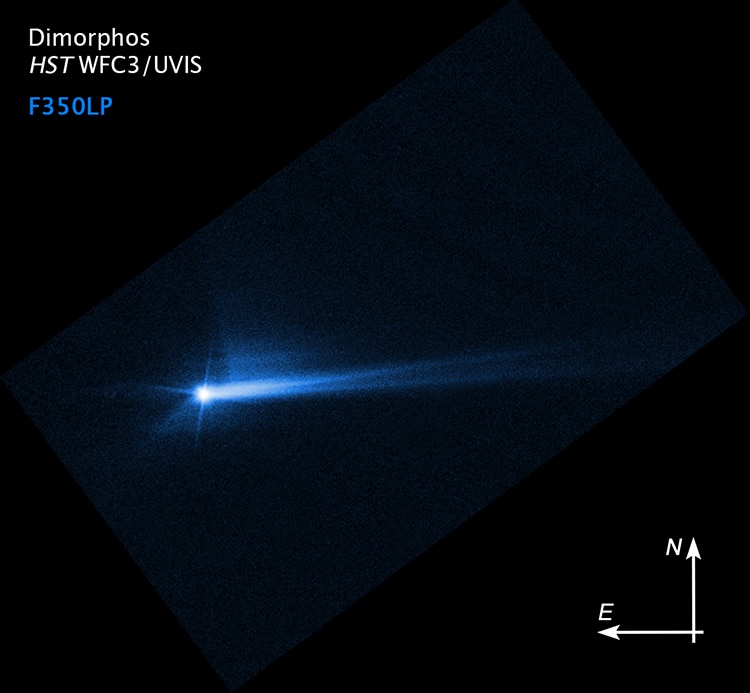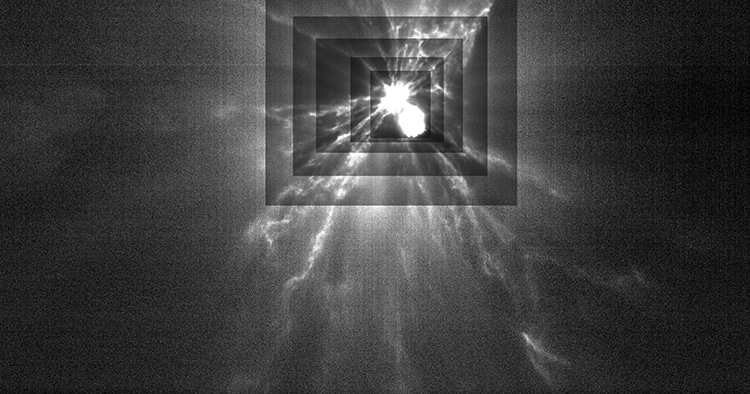
Photo by the SOAR Telescope in Chile showing a side view of the streams of material from the surface of Dimorphos two days after the asteroid was impacted by NASA’s DART spacecraft. (Photo: CTIO/NOIRLab/SOAR/NSF/AURA/T. Kareta (Lowell Observatory), M. Knight (US Naval Academy))
Someday an asteroid might threaten Earth. In preparation for that day, NASA has been strategizing how to deflect incoming celestial bodies. This plan for planetary defense was recently tested for the first time when the DART mission’s spacecraft collided intentionally with a small asteroid named Dimorphos which currently poses no danger to us. The results are now in: the collision shortened the period of Dimorphos’ orbit.
On September 26, 2022, NASA’s 1,300-pound spacecraft smashed into the small asteroid, which is about the size of a stadium. The $330 million mission was off to a successful start. However scientists had to wait to analyze data to see if the impact shifted the orbit of the asteroid around its larger counterpart Didymos. Even a small difference of 73 seconds would be a successful mission. The team was hoping for a 10-mute drop in the period of the orbit. Instead, they have since registered a shocking 32-minute drop indicating the asteroid was substantially knocked off its old path. It dropped from 11 hours and 55 minutes to 11 hours and 23 minutes.
“When I saw Dimorphos coming into view, and when I saw there was not a single crater on it, and there were a lot of what appeared to be loose rocks…I looked at it and I said, ‘This is not going to be 73 seconds,’” Tom Statler, a NASA program scientist, explained. “And it wasn’t.” This is a huge step for planetary defense. Shifting an oncoming asteroid’s path may be critical to human survival one day.
“One of the key pieces to being successful with implementing a technique like this is early detection: The more time we have for that little nudge and the change in that orbital period, the better off we are,” said Lori Glaze, NASA’s planetary science division director. “Give that little nudge, such that the asteroid crosses over Earth’s path, either just before we get there or just after we’ve gone by, so that we don’t actually end up in the same place at the same time.”
NASA’s DART mission to collide a spacecraft with an asteroid in the hopes of changing its orbit has proved successful.

NASA’s Hubble Space Telescope on Oct. 8, 2022, captured the debris blasted from the surface of Dimorphos 285 hours after the asteroid impacted. (Photo: NASA/ESA/STScI/Hubble)
The length of Dimorphos’s orbit dropped from 11 hours and 55 minutes to 11 hours and 23 minutes, a large change of 32 minutes.

An image from ASI’s LICIACube show the plumes of ejecta streaming from Dimorphos after impact. (Photo: ASI/NASA/APL)
h/t: [Mashable]
Related Articles:
NASA’s JunoCam Shares Stunning Rendering of Jupiter’s “Frosting-Like” Clouds
This NASA Astronaut Will Become the First Native American Woman in Space
New Poll Finds Most Americans Support NASA’s $10B Investment in James Webb Space Telescope
